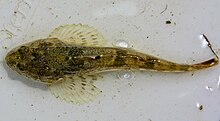Bullheads
| Bullheads | ||||||||||||
|---|---|---|---|---|---|---|---|---|---|---|---|---|

Bullhead ( Cottus gobio ) |
||||||||||||
| Systematics | ||||||||||||
|
||||||||||||
| Scientific name | ||||||||||||
| Cottidae | ||||||||||||
| Bonaparte , 1832 |
The bullheads (Cottidae) are a family of bony fish. They live in the cold fresh waters of the northern continents, most of the species endemic to the Siberian Lake Baikal . Only the genus Leptocottus occurs in the sea on the coast of the northern Pacific. Most of the numerous other marine genera that were originally counted among the bullheads were transferred to the family of the thick-headed bullheads (Psychrolutidae) in a revision of the terracotta system . In contrast, the bullheads of Lake Baikal, which originally belonged to independent families (Abyssocottidae, Comephoridae and Cottocomephoridae), were placed in the bullhead family.
The bullhead ( Cottus gobio ) is one of the best-known and native species . Other species that occur in Germany are the Scheldtroppe ( Cottus perifretum ) and the Rheingroppe ( Cottus rhenanus ).
features
Bullheads have a stocky, scaly body that tapers sharply at the back. The large head is often flattened, partially armored and has spikes. Adults do not have a swim bladder . The eyes are usually large and set high on the head, there is a lateral line organ . The ventral fins , which lie far forward, are supported by one hard and two to five soft rays. Bullheads have two dorsal fins and are 6 to 46 ( Leptocottus armatus ) inches long. The Branchiostegalmembranen have grown together at the isthmus .
Genera and species
There are 18 genera and 107 species.
| Phylogenetic system of bullheads according to Kinziger et al. 2005: | |||||||||||||||||||||||||||||||||||||||||||||||||||
|---|---|---|---|---|---|---|---|---|---|---|---|---|---|---|---|---|---|---|---|---|---|---|---|---|---|---|---|---|---|---|---|---|---|---|---|---|---|---|---|---|---|---|---|---|---|---|---|---|---|---|---|
|
|||||||||||||||||||||||||||||||||||||||||||||||||||

- Genus Cephalocottus Gratzianov, 1907
- Cephalocottus amblystomopsis Schmidt, 1904
- Cephalocottus nozawae Snyder, 1911
- Genus Cottopsis Girard, 1850
- Cottopsis aleuticus Gilbert, 1896
- Cottopsis asper Richardson, 1836
- Cottopsis asperrimus Rutter, 1908
- Cottopsis gulosus (Girard, 1854)
- Cottopsis klamathensis Gilbert, 1898
- Cottopsis marginatus (Bean, 1881)
- Cottopsis perplexus Gilbert & Evermann, 1894
- Cottopsis pitensis Bailey & Bond, 1963
- Cottopsis princeps Gilbert, 1898
- Genus Cottus Linnaeus, 1758; Type genus
- Genus Leptocottus Girard, 1854
- Leptocottus armatus Girard, 1854
- Genus Mesocottus Gratzianov, 1907
- Mesocottus haitej (Dybowski, 1869)
- Genus Rheopresbe Jordan & Starks, 1904
- Rheopresbe kazika (Jordan & Starks), 1904
- Genus Trachidermus Heckel, 1837, anadromous
- Trachidermus fasciatus Heckel, 1837
- Genus Uranidea DeKay, 1842.
- Uranidea baileyi Robins, 1961
- Uranidea bairdii Girard, 1850
- Uranidea bendirei (Bean, 1881)
- Uranidea caeruleomentum Kinziger, Raesly & Neely, 2000
- Uranidea carolinae (Gill, 1861)
- Uranidea cognatus Richardson, 1836
- Uranidea extensus Bailey & Bond, 1963
- Uranidea girardi Robins, 1961
- Uranidea hubbsi Bailey & Dimick, 1949
- Uranidea hypselurus Robins & Robison, 1985
- Uranidea paulus Williams, 2000
- Uranidea rhotheus (Smith, 1882)
- Uranidea specus Adams et al., 2013
- Baikal pellets
- Genus Abyssocottus
- Abyssocottus elochini Taliev, 1955.
- Abyssocottus gibbosus Berg, 1906.
- Abyssocottus korotneffi Berg, 1906.
- Genus Asprocottus
- Asprocottus abyssalis Taliev, 1955.
- Asprocottus herzensteini Berg, 1906.
- Asprocottus intermedius Taliev, 1955.
- Asprocottus korjakovi minor Sideleva, 2001.
- Asprocottus minor Sideleva, 2001.
- Asprocottus parmiferus Taliev, 1955.
- Asprocottus platycephalus Taliev, 1955.
- Asprocottus pulcher Taliev, 1955.
- Genus Batrachocottus
- Batrachocottus baicalensis (Dybowski, 1874)
- Batrachocottus multiradiatus Berg, 1907
- Batrachocottus nikolskii (mountain, 1900)
- Batrachocottus talievi Sideleva, 1999
- Genus Baikal oilfish ( Comephorus , Lacépède, 1800)
- Large Baikal oilfish ( Comephorus baikalensis ) (Pallas, 1776)
- Small Baikal oilfish ( Comephorus dybowskii ) Korotneff, 1904
- Genus Cottinella
- Cottinella boulengeri (Berg, 1906).
- Genus Cottocomephorus
- Cottocomephorus alexandrae Taliev, 1935
- Cottocomephorus grewingkii (Dybowski, 1874)
- Cottocomephorus inermis (Yakovlev, 1890)
- Genus Cyphocottus
- Cyphocottus eurystomus (Taliev, 1955).
- Cyphocottus megalops (Gratzianov, 1902).
- Genus Leocottus
- Leocottus kesslerii (Dybowski, 1874)
- Genus Limnocottus
- Limnocottus bergianus Taliev, 1935.
- Limnocottus godlewskii (Dybowski, 1874).
- Limnocottus griseus (Taliev, 1955).
- Limnocottus pallidus Taliev, 1948.
- Genus Neocottus
- Neocottus thermalis Sideleva, 2002.
- Neocottus werestschagini (Taliev, 1935).
- Genus Paracottus
- Paracottus knerii (Dybowski, 1874)
- Genus Procottus
- Procottus gotoi Sideleva, 2001.
- Procottus gurwicii (Taliev, 1946).
- Procottus jeittelesii (Dybowski, 1874).
- Procottus major Taliev, 1949.
- Genus Abyssocottus
Individual evidence
- ^ A b c W. Leo Smith & Morgan S. Busby: Phylogeny and Taxonomy of Sculpins, Sandfishes, and Snailfishes (Perciformes: Cottoidei) with Comments on the Phylogenetic Significance of their Early-Life-History Specializations. Molecular Phylogenetics and Evolution, July 8, 2014, doi: 10.1016 / j.ympev.2014.06.028
- ↑ Ricardo Betancur-R, Edward O. Wiley, Gloria Arratia, Arturo Acero, Nicolas Bailly, Masaki Miya, Guillaume Lecointre and Guillermo Ortí: Phylogenetic classification of bony fishes . BMC Evolutionary Biology, BMC series - July 2017, DOI: 10.1186 / s12862-017-0958-3
- ^ Joseph S. Nelson : Fishes of the World , John Wiley & Sons, 2006, ISBN 0-471-25031-7
- ↑ Leptocottus armatus on Fishbase.org (English)
- ↑ Andrew P. Kinziger, Robert M. Wood, David A. Neely: Molecular Systematics of the Genus Cottus (Scorpaeniformes: Cottidae). Copeia , 2005 (2): 303-311. 2005. doi: 10.1643 / CI-03-290R1
- ↑ Goto, A., Yokoyama, R., Kinoshita, I. & Sakai, H. (2019): Japanese catadromous fourspine sculpin, Rheopresbe kazika (Jordan & Starks) (Pisces: Cottidae), transferred from the genus Cottus. Environmental Biology of Fishes, November 2019.
- ↑ Species list of the former Abyssocottidae family at Fishbase
- ↑ List of species of the former Comephoridae family at Fishbase
- ↑ Species list of the former Cottocomephoridae family at Fishbase
Web links
- Bullet on Fishbase.org (English)



